-
Countries
-
Data and Analysis
-
Special Focus
-
Crisis Responses

Contact
IraqDTM@iom.int
Language
English
Location
Iraq
Period Covered
Apr 01 2023
Sep 03 2023
Activity
- Mobility Tracking
- Event Tracking
Due to an observed increase in inflows to Sinjar and Al-Ba’aj districts trigged by social tension between Yazidis and other residents, the International Organization for Migration’s (IOM) Displacement Tracking Matrix (DTM) in Iraq launched an emergency tracking tool in April 2023 to understand the number of people in movement and their main characteristics.
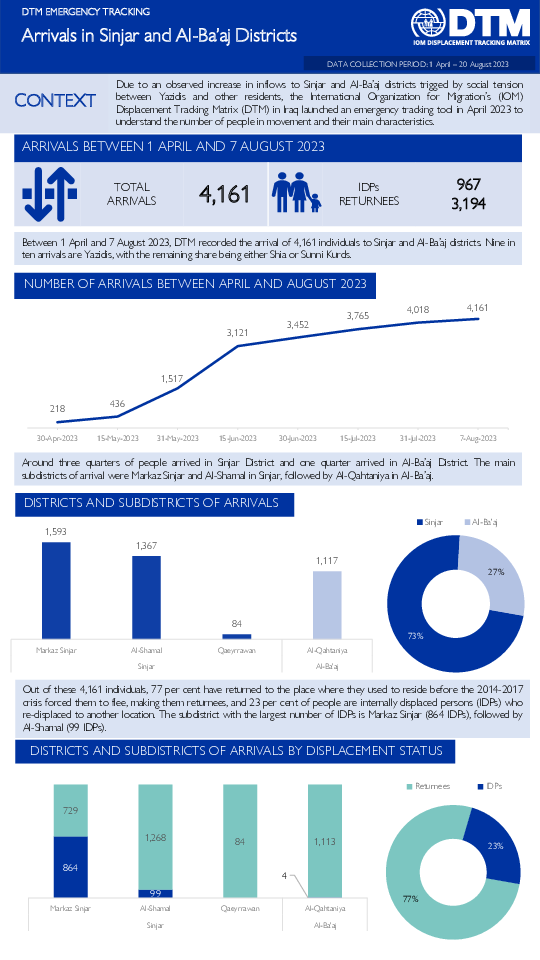
Contact
IraqDTM@iom.int
Language
English
Location
Iraq
Period Covered
Apr 01 2023
Aug 20 2023
Activity
- Mobility Tracking
- Event Tracking
Due to an observed increase in inflows to Sinjar and Al-Ba’aj districts trigged by social tension between Yazidis and other residents, the International Organization for Migration’s (IOM) Displacement Tracking Matrix (DTM) in Iraq launched an emergency tracking tool in April 2023 to understand the number of people in movement and their main characteristics.
Contact
dtmuganda@iom.int vwabwire@iom.in
Location
Uganda
Activity
- Mobility Tracking
- Event Tracking
- Baseline Assessment
Period Covered
Mar 10 2024 -Mar 29 2024
In March, the impacts of the hazards affected 10,390 individuals (2,387 households), with 426 people from 91 households were internally displaced. Children below the age of 18 were the most affected age group (67%), followed by adults (18-64) at 30% and elderly above 64 (3%). Notably, more than half of affected people were female (62%).
A more detailed version of this dataset, including the number of the vulnerabilities, is available. To get access, kindly click on the 'Request Access' button.
Population Groups
IDPs
Residents
Survey Methodology
Unit of Analysis Or Observation
Admin Area 2
Admin Area 3
Community
Type of Survey or Assessment
Key Informant
Keywords
Geographical Scope Partial Coverage
Administrative boundaries with available data
The current dataset covers the following administrative boundaries
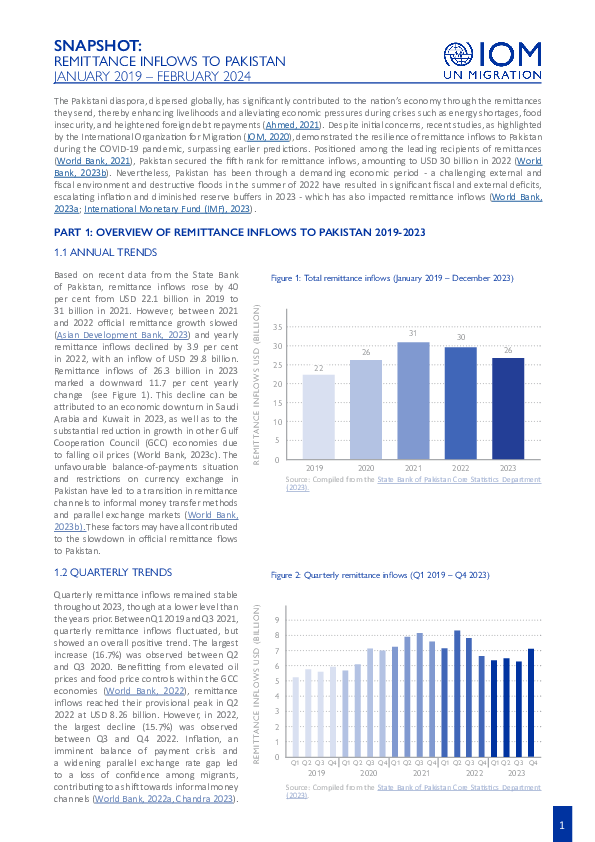
Contact
rdhroapsupport@iom.int, dtmremapsupport@iom.int
Language
English
Location
Pakistan
Period Covered
Jan 01 2019
Feb 29 2024
Activity
- Other
This report on remittance inflows to Pakistan from 2019 to 2024 details the fluctuating trends in money sent home by the Pakistani diaspora. The report highlights the economic impact of these financial transfers. Initially, remittances grew significantly, reaching USD 31 billion in 2021, but this was followed by a decline, with 2023 seeing a drop to USD 26.3 billion, largely due to economic issues in the Gulf Cooperation Council countries and restrictive financial policies in Pakistan. Despite these challenges, remittance inflows remained a critical source of foreign exchange and economic stability, particularly during crises such as the COVID-19 pandemic and the 2022 floods.
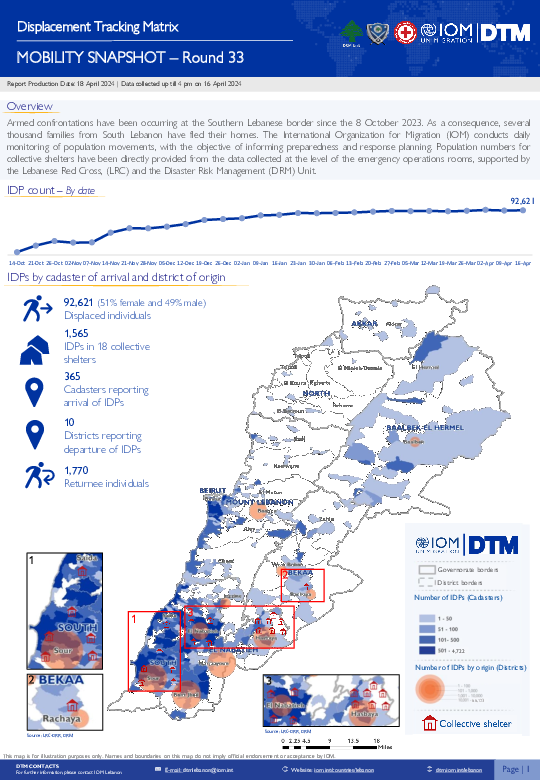
Contact
dtmlebanon@iom.int
Language
English
Location
Lebanon
Period Covered
Oct 10 2023
Apr 16 2024
Activity
- Mobility Tracking
- Baseline Assessment
Since October 8 there has been an increase in cross-border incidents between Israel and Lebanon, resulting in the displacement of people both within the South and elsewhere within the country. Since October 10, the Displacement Tracking Matrix (DTM) has been conducting the daily monitoring of population movements. The objective of the exercise is to inform preparedness and response planning.
Contact
DTM Yemen, iomyemendtm@iom.int
Location
Yemen
Activity
- Mobility Tracking
- Event Tracking
Period Covered
Apr 07 2024 -Apr 13 2024
From 1 January to 13 April 2024, IOM Yemen DTM tracked 961 households (HH) (5,766 Individuals) who experienced displacement at least once.
Between 7 and 13 April 2024, IOM Yemen DTM tracked 7 households (42 individuals) displaced at least once. The majority of people moved into/within the following governorates and districts:
- Ma’rib (7 HHs) – Harib (4 HHs), Ma’rib City (2 HHs), Ma’rib (1 HH) districts. Most displacements in the governorate originated from Al Jawf and Al Hodeidah.
The majority of people moved from the following governorates and districts:
- Al Jawf (4 HHs) – Al Humaydat (4 HHs) district.
- Al Hodeidah (1 HH) – Ad Dohi (1 HH) district.
- Ta’iz (1 HH) – Al Mudhaffar (1 HH) district.
Population Groups
Survey Methodology
Unit of Analysis Or Observation
Type of Survey or Assessment
Keywords
Geographical Scope
Administrative boundaries with available data
The current dataset covers the following administrative boundaries
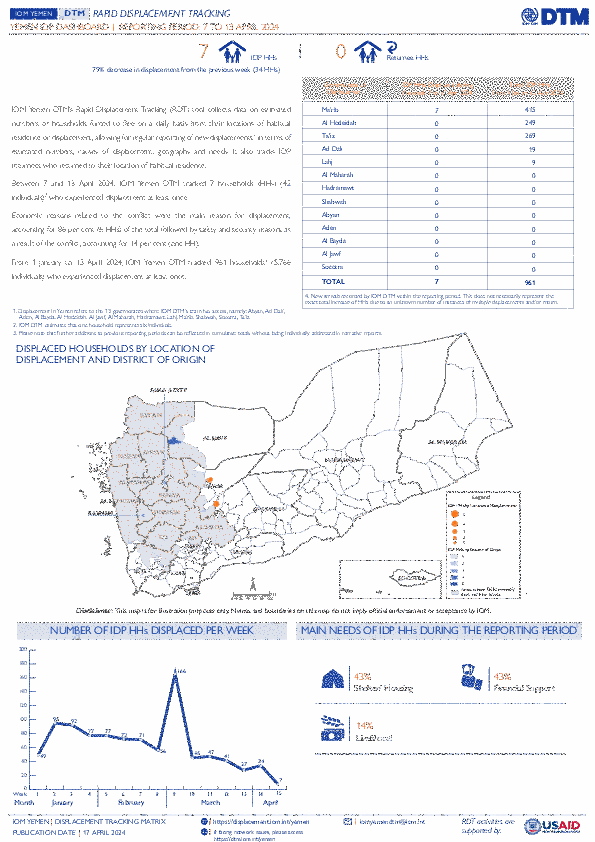
Contact
DTM Yemen, iomyemendtm@iom.int
Language
English
Location
Yemen
Period Covered
Apr 07 2024
Apr 13 2024
Activity
- Mobility Tracking
- Event Tracking
IOM Yemen DTM's Rapid Displacement Tracking (RDT) tool collects data on estimated numbers of households forced to flee on a daily basis from their locations of origin or displacement, allowing for regular reporting of new displacements in terms of estimated numbers, geography, and needs. It also tracks returnees who returned to their location of origin.
From 1 January to 13 April 2024, IOM Yemen DTM tracked 961 households (HH) (5,766 Individuals) who experienced displacement at least once.
Between 7 and 13 April 2024, IOM Yemen DTM tracked 7 households (42 individuals) displaced at least once. The majority of people moved into/within the following governorates and districts:
- Ma'rib (7 HHs) – Harib (4 HHs), Ma'rib City (2 HHs), Ma'rib (1 HH) districts. Most displacements in the governorate originated from Al Jawf and Al Hodeidah.
The majority of people moved from the following governorates and districts:
- Al Jawf (4 HHs) – Al Humaydat (4 HHs) district.
- Al Hodeidah (1 HH) – Ad Dohi (1 HH) district.
- Taiz (1 HH) – Al Mudhaffar (1 HH) district.
IOM identified 7 displaced households in the previous reporting period, which covered 31 March - 06 April 2024, in the governorates of Ma'rib (6 HHs), and Al Hodeidah (1 HH). These figures have been added to the cumulative displacement total recorded since the beginning of the year.
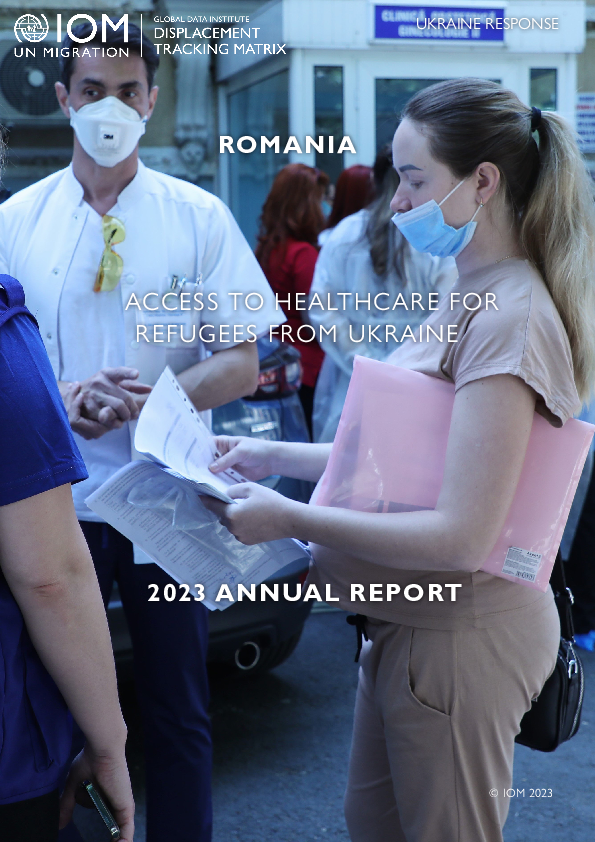
Contact
DTM Europe, DTMMediterranean@iom.int
Language
English
Location
Romania
Period Covered
Jan 01 2023
Jan 31 2024
Activity
- Survey
Key findings:
- Specific needs* include chronic diseases or serious medical conditions (60%), visual impairment (18%), mobility impairment (8%) and pregnant or lactating women (8%).
- Priority needs include medicine (32%) and healthcare services (67%).
- More male respondents reported needing medicine (35%) than their female counterparts (31%)
- Female respondents required healthcare services (69%) more than men (65%).
- Groups with elderly required medicine (40%) more than healthcare services (30%).
- Groups with children needed healthcare services (56%) more than medicine (46%),
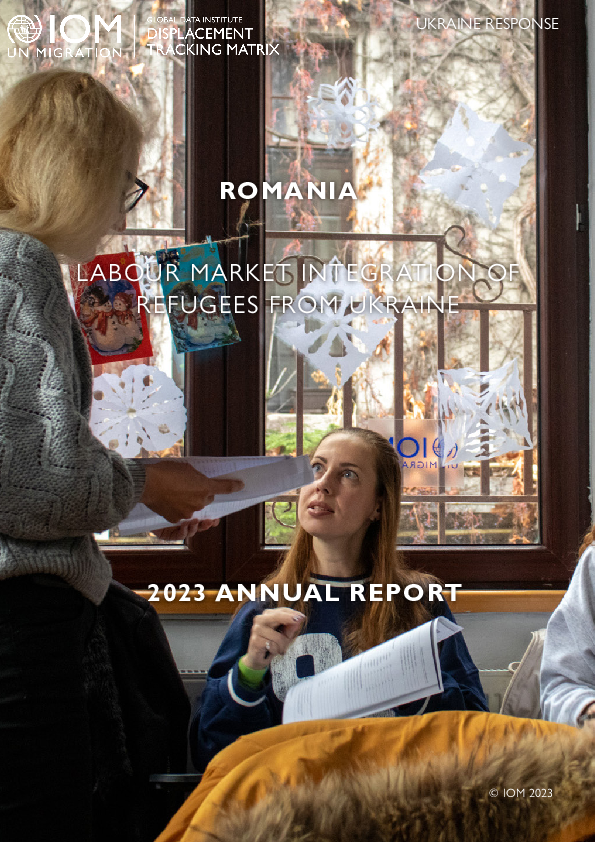
Contact
DTM Europe, DTMMediterranean@iom.int
Language
English
Location
Romania
Period Covered
Jan 01 2023
Dec 31 2023
Activity
- Survey
Key Findings:
- Among respondents, 43 per cent are active (employed or unemployed), and 46 per cent are inactive (student status, parental leave, retirement, unemployment and not looking for a job).
- Within active population, 54 per cent are employed and 46 are unemployed.
- 90 per cent of respondents do not speak Romanian
- Top barriers to employment include: language barrier (55%), where to find jobs (40%) and lack of jobs suited to qualifications (40%)5
- Top reasons for unemployment and not looking for a job: parental leave (39%), helping family (15%), retired (15%) and no need to work (14%)
- Top occupations: services and sales (28%), plants and machinery operations (21%), education (16%), administrative fields (9%)
